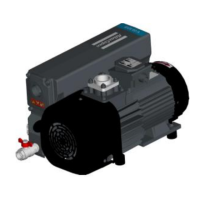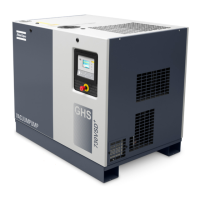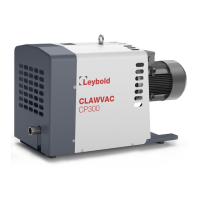Instruction book
38 6996 0224 30
Installation guidelines
The following list must be used as a guide for the installation of GVS vacuum pumps. The list is not
exhaustive. Every vacuum pump installation is unique and care must be exercised in the placement of
each pump. If you are unsure of any installation variable, please consult Atlas Copco.
Install the pump on a solid, level surface, suitable for taking its weight. Respect the minimal distance
between the pump and the walls (see drawing).
Correct process lines sizes have to be used to prevent restrictions and resulting pressure drops. As a
rule of thumb, the inlet diameter of the pump should be maintained as far into the process as possible.
Consult Atlas Copco for piping recommendations.
The required ventilation capacity to limit the vacuum pump room temperature can be calculated from
Qv = 0.2 N/Δt, with
Qv = required ventilation capacity in m
3
/s
N = shaft input of the vacuum pump in kW.
Δt = temperature increase of the incoming ventilation air in the vacuum pump room in °C
Make sure all piping connections from the pump to the point of use are leak tight and secure. Leaks
add load to the vacuum pump. They decrease the available pump capacity and spoil the attainable
ultimate pressure. All welds must be vacuum compatible.
Vacuum rated isolation valves must be used. Compressed air valves and vacuum valves differ in their
sealing characteristics and compressed air valves may leak in vacuum applications.
All piping should be as straight as possible with non-restrictive diameters. Elbows, bends, tees and
tapers should be used only when absolutely necessary.
Keep plumbing and system free of fluids, water, dirt, and debris that are not part of the process. These
can cause obstructions in the vacuum flow through the piping and can reduce available pumping
capacity.
Exhaust piping should be installed in such a manner that it does not create additional back pressure on
the vacuum pump. Also, the exhaust piping should be installed sloping away from the vacuum pump.
A recommended alternative is the use of a drip leg with drain point provision, to prevent condensate
from running back into the fluid reservoir.
Take extreme care in selecting the proper inlet filtration system for the vacuum pump. Liquids, solids
and abrasive powders must be prevented from entering the vacuum pump to prevent mechanical
failure or reduced lifetime. Inlet filtration must be installed on every pump. The potential for particulate
contamination in rough vacuum applications is significant. The particle micron retention of the filter
element must be smaller than the smallest possible particle load. Also, the inlet filter should be
mounted in such a way to prevent particles from falling into the inlet of the vacuum pump during
cleaning or changing of the filter element.
If there is a risk for liquids to be drawn into the vacuum system, a liquid separator should be used to
separate these liquids from the incoming air. In applications where there is significant amount of liquid,
consult Atlas Copco.
Keep the vacuum pump room dry and free from contamination.
Follow recommended lubricant change schedules in normal applications (air) and watch closely the
condition and appearance of the fluid in chemical or harsh applications. Check the leak rate of the
system by pumping down to the ultimate pressure and then valve off the vacuum pump. Monitor the
pressure rise over a period of five or ten minutes and record this rate of rise for future reference. This
value is a good tool to have if you believe there are pump or system problems. Compare new value
with the original.
When pumping condensable vapours and particulates, more frequent fluid changes are required to
maintain pump life. Consult Atlas Copco about types and styles of filtration units.

